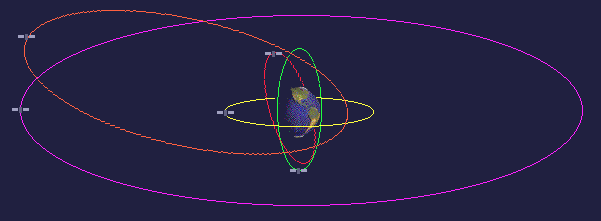PROG0545 - Vis viva
In the history of science, vis viva (Latin for living force) is an obsolete scientific theory that served as an elementary and limited early formulation of the law of conservation of energy. It was the first known description of what we now call kinetic energy or of energy related to sensible motions. Proposed by Gottfried Leibniz over the period 1676–1689, the theory was controversial as it seemed to oppose the theory of conservation of momentum advocated by Sir Isaac Newton and René Descartes. The two theories are now understood to be complementary. Leibniz used the term living force to refer to the total kinetic energy of an isolated system.
The theory was eventually absorbed into the modern theory of energy though the term still survives in the context of celestial mechanics through the vis viva equation. Satellites make an elliptic orbit around the Earth according classic (Newtonian) astrodynamics.
Input
There are two lines of input, each containing a single floating point number. The first number is the distance $r$ between a satellite and the center of the Earth (expressed in meters). The second number is the speed $v$ of the satellite relative to the Earth (expressed in meters/second).
Output
Based on the given data from the input, the length $a$ of the semi-major axis of the elliptic orbit the satellite makes around the Earth can be computed. This can be done by rewriting the vis viva equation: $$ a = \frac{\mu r}{2\mu - r v^2} $$ The period of the satellite (expressed in seconds) can be computed as $2\pi \sqrt{\frac{a^3}{\mu}}$.
Three lines of output need to be generated. The first line contains the length $a$ of the semi-major axis of the elliptic orbit, expressed in meters. The second line contains the length of the period, expressed in seconds. The third line contains the length of the period, expressed as an integer number of days $d$, hours $h$ and minutes $m$ that completely fall within the period. Make sure that $0 \leq d < 24$ and that $0 \leq m < 60$. Take a look at the examples given below, to see how the output needs to be formatted precisely.
Example
Satellite: the International Space Station (ISS)
Input:
6792000 7658
Output:
major axis: 6787166.808499204 meters period: 5564.7257424392155 seconds period: 0 days, 1 hours and 32 minutes
Example
Satellite: ASTRA 1L, a geostationary satellite which broadcasts BVN among other TV channels
Input:
35785400 3580.9
Output:
major axis: 42160215.133579694 meters period: 86151.96905571753 seconds period: 0 days, 23 hours and 55 minutes
Example
Satellite: PROBA-2
Input:
7104000 7485
Output:
major axis: 7093371.63898765 meters period: 5945.52283951033 seconds period: 0 days, 1 hours and 39 minutes
Example
Satellite: the Moon
Input:
400000000 977.75
Output:
major axis: 384375790.60599077 meters period: 2371619.541180138 seconds period: 27 days, 10 hours and 46 minutes
Vis viva (van het Latijn voor levende kracht) is een achterhaalde wetenschappelijke theorie die kan beschouwd worden als voorloper van de wet van behoud van energie. Ze gaf voor het eerst een beschrijving van de kinetische energie. De levende kracht verwees hierbij naar alle kinetische energie in een geïsoleerd systeem.
Vandaag is de vis viva theorie opgenomen en vervangen door de moderne theorie van energie. In de sterrenkunde leeft de naam echter voort in de vorm van de vis viva vergelijking. Volgens de klassieke (Newtoniaanse) hemelmechanica draaien satellieten rond de Aarde in een ellipsvormige baan.
Invoer
De invoer bestaat uit twee floating point getallen, die elk op een afzonderlijke regel staan. Het eerste getal is de afstand $r$ tussen een satelliet en het middelpunt van de Aarde (uitgedrukt in meter). Het tweede getal is de snelheid $v$ van de satelliet ten opzichte van de Aarde (uitgedrukt in meter/seconde).
Uitvoer
Op basis van deze gegevens kan je de lengte $a$ (in meter) van de grote as berekenen van de elliptische baan waarin de satelliet rond de Aarde draait. Dit doe je door de vis viva vergelijking te herschrijven: $$ a = \frac{\mu r}{2\mu - r v^2} $$ De periode van de satelliet (uitgedrukt in seconden) bekom je door $2\pi \sqrt{\frac{a^3}{\mu}}$ te berekenen.
Er moeten drie regels uitvoer uitgeschreven worden. De eerste regel bevat de lengte van de grote as $a$, uitgedrukt in meter. De tweede regel bevat de lengte van de periode, uitgedrukt in seconden. De derde regel bevat de lengte van de periode, uitgedrukt in een geheel aantal dagen $d$, uren $u$ en minuten $m$ die volledig binnen de periode passen. Hierbij moet gelden dat $0 \leq d < 24$ en dat $0 \leq m < 60$. Bekijk onderstaande voorbeelden om te achterhalen hoe de uitvoer precies moet uitgeschreven worden.
Voorbeeld
Satelliet: het internationaal ruimtestation ISS
Invoer:
6792000 7658
Uitvoer:
grote as: 6787166.808499204 meter periode: 5564.7257424392155 seconden periode: 0 dagen, 1 uren en 32 minuten
Voorbeeld
Satelliet: ASTRA 1L, een geostationaire satelliet die onder andere BVN uitzendt
Invoer:
35785400 3580.9
Uitvoer:
grote as: 42160215.133579694 meter periode: 86151.96905571753 seconden periode: 0 dagen, 23 uren en 55 minuten
Voorbeeld
Satelliet: PROBA-2
Invoer:
7104000 7485
Uitvoer:
grote as: 7093371.63898765 meter periode: 5945.52283951033 seconden periode: 0 dagen, 1 uren en 39 minuten
Voorbeeld
Satelliet: de Maan
Invoer:
400000000 977.75
Uitvoer:
grote as: 384375790.60599077 meter periode: 2371619.541180138 seconden periode: 27 dagen, 10 uren en 46 minuten
| Added by: | Peter Dawyndt |
| Date: | 2015-08-06 |
| Time limit: | 10s |
| Source limit: | 50000B |
| Memory limit: | 1536MB |
| Cluster: | Cube (Intel G860) |
| Languages: | PY_NBC |



 RSS
RSS